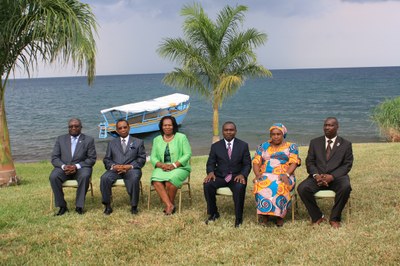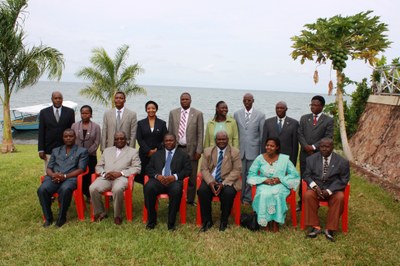Background/Goals
The Lake Tanganyika Authority (LTA) was launched in December 2008 as an institution management structure that includes the Conference of Ministers, the Management Committee and the Secretariat. The overall objective of the Convention is to ensure the protection and conservation of the biological diversity and sustainable use of the natural resources of Lake Tanganyika and its basin. To achieve the Convention’s overall objective, a Strategic Action Program (SAP) was developed and endorsed by the four riparian countries.
 The Conference of Ministers is the supreme organ of the LTA and consists of four Ministers, one from each of the Lake Tanganyika riparian countries. The major function of the Conference of Ministers is to evaluate the implementation of the Convention on the Sustainable Management of Lake Tanganyika, which was signed on 12th June 2003 by the riparian countries of Burundi, Democratic Republic of Congo, Tanzania and Zambia. The Convention unites the countries in recognizing that Lake Tanganyika is a shared heritage with unique biological and other diversity. The Convention also recognizes the significance of Lake Tanganyika for the development of the riparian states, and the necessity of establishing a sustainable legal and institutional framework for cooperative management of the lake.
The Conference of Ministers is the supreme organ of the LTA and consists of four Ministers, one from each of the Lake Tanganyika riparian countries. The major function of the Conference of Ministers is to evaluate the implementation of the Convention on the Sustainable Management of Lake Tanganyika, which was signed on 12th June 2003 by the riparian countries of Burundi, Democratic Republic of Congo, Tanzania and Zambia. The Convention unites the countries in recognizing that Lake Tanganyika is a shared heritage with unique biological and other diversity. The Convention also recognizes the significance of Lake Tanganyika for the development of the riparian states, and the necessity of establishing a sustainable legal and institutional framework for cooperative management of the lake.
 The second organ of the LTA is the Management Committee, which consists of four members from each Lake Tanganyika riparian country representing fisheries, environment, water and finance sectors. The LTA Executive Director is an ex-officio member of the Management Committee. The major function of the Management Committee is to support, coordinate and monitor the implementation of the Convention on the Sustainable Management of Lake Tanganyika.
The second organ of the LTA is the Management Committee, which consists of four members from each Lake Tanganyika riparian country representing fisheries, environment, water and finance sectors. The LTA Executive Director is an ex-officio member of the Management Committee. The major function of the Management Committee is to support, coordinate and monitor the implementation of the Convention on the Sustainable Management of Lake Tanganyika.
The third organ of the LTA is the Secretariat which consists of the Executive Director, Deputy Executive Director and four Directors each responsible for i) Environment, ii) Fisheries, iii) Finance & Administration and iv) Monitoring & Evaluation. The major function of the Secretariat is to oversee implementation of program and project activities in accordance with the provisions of the Convention and perform other functions determined by the Management Committee and the Conference of Ministers. The Conference of Ministers is the supreme organ of the LTA and consists of four Ministers, one from each of the Lake Tanganyika riparian countries.
SAP priorities include effective operations of the LTA organs, improvement of community infrastructure and improvement in water treatment, development of stakeholders’ capacity in sustainable management of fisheries resources, reduction of water pollution and sedimentation flows into the lake, and establishment of an integrated regional monitoring system.
Document Actions













